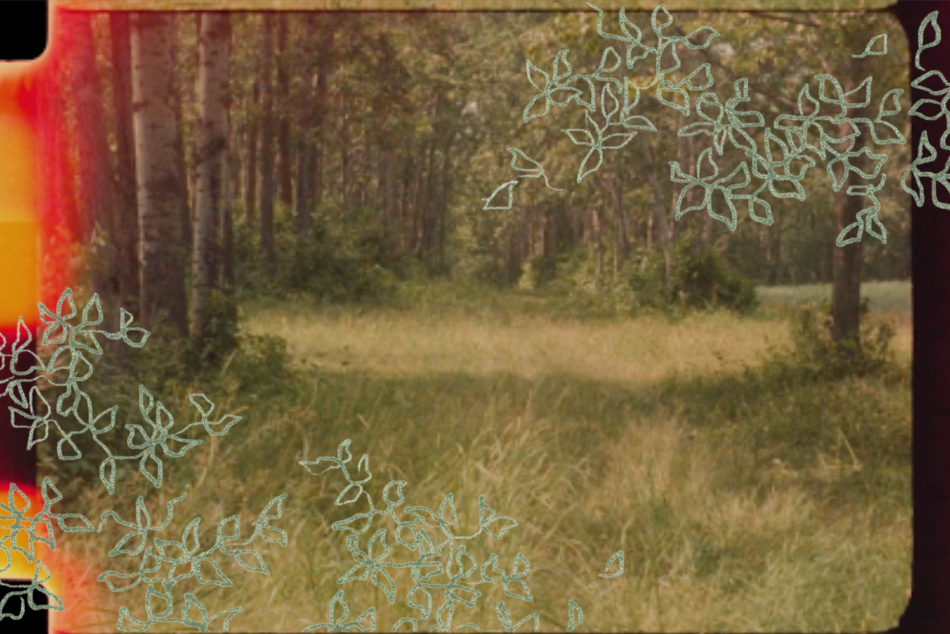êpêkiyokêyân holds visiting at its heart.
Kiona Callihoo Ligtvoet is Cree and Métis descending from Michel Band. Seth Arcand is a Cree filmmaker from the kipohtakaw Cree Nation (Alexander). Their communities neighboured on the prairies before the enfranchisement of Michel band in 1958. Not neighbours in the colonial sense of white picket fences and carefully marked yet arbitrary border lines, but neighbours that hold to the nehiyaw law of wahkohtowin, with shared landmarks, and shared understandings of place across generations that don’t hold to the rigidity of colonial borders. In making this work, Kiona and Seth explored the unmarked spots and gravel roads between where they each grew up, understanding the land from the distance between landmarks, from the desire paths that remain, and the roads that cover the ones that existed before.
êpêkiyokêyân exists as an archive of visits. Kiona & Seth’s practices overlap within the archive. As a painter and multidisciplinary artist, Kiona’s practice explores archiving as an ongoing love letter - a documentation of moments from the land she grew up on, with snippets of stories that hold their secrets close. Seth’s work as a filmmaker explores the nehiyaw laws of pimatisiwin and wahkohtowin - of balance, and of kinship, documenting these stories as a way of reclaiming his place between the prairie grass and sky.
Their archive doesn’t hold to the restrictiveness of academia, but instead playfully holds stories: visits to Kiona’s moshom’s farm to pick cranberries, wild mint, and saskatoons, each visit beginning with a mark in the calendar for the next. Stories told while sitting together, wandering around the bush in hi-vis vests, and following the desire paths between. A pocket knife accidentally flung into bushes during harvest, to be found when the snow melts in springtime. Tea made from mint harvested on the farm, in chipped mugs around a kitchen table.
êpêkiyokêyân holds visiting at its heart. It leaves desire paths for you to follow, to visit these stories and to understand their importance. It holds space to rest at the kitchen table, to trace your fingers along the paths burned within it, to consider how to hold relationships close.
Desire path: an unplanned route or path (such as one worn into a grassy surface by repeated foot traffic) that is used by pedestrians in preference to or in the absence of a designated alternative (such as a paved pathway).
Seth Arcand is a Cree filmmaker from the kipohtakaw Cree Nation (Alexander) in so called Alberta. His interests lie in exploring Indigenous stories through film and photography. As a filmmaker, he hopes to open up more opportunity for other Indigenous filmmakers interested in the industry. This means creating spaces on the prairies where Indigenous filmmakers are comfortable and supported in taking risks, while challenging what is expected of Indigenous Creatives. Visiting and reciprocity are important aspects of his creative process. Seth recently completed a certificate in the Indigenous Digital Filmmaking Program at Capilano University, and was selected to participate in Write Over Here: Indigenous Screenwriting Residency 2025 at Banff Centre for the Arts. Still residing in kipohtakaw, Seth is connected to his community, and is still learning about his culture as he believes this is a lifelong process.
Kiona Callihoo Ligtvoet (she/her) is a multidisciplinary artist practicing in amiskwaciwâskahikan on Treaty 6 Territory. She grew up West of the city near the hamlet of Calahoo where she lived with her relatives on a quarter section of land her moshom cares for. Her family lines are Cree and Métis descending from Michel Band, as well as Dutch and mixed European. Kiona works in painting, printmaking, drawing and installation, recollecting personal stories of grief and tenderness. Her practice uses a non-linear telling of her memories through narrative work as a form of diaristic archiving. It draws from feelings of loss and enfranchisement, but also from deep belly laughter, mundane gestures, and a gentle fondness for where the histories between herself and her family overlap and disperse. Kiona co-organizes Making Space in partnership with Sanaa Humayun. She likes visiting her moshom on the farm, and gossiping with her mom, relatives, and friends on the prairies.
Acknowledgements:
Thank you to the Edmonton Arts Council and the Alberta Foundation for the Arts for funding the works produced in êpêkiyokêyân, coming to visit.
The table was designed and built by Colbey Shaw for this project, and wood burned by Kiona and Seth. We’re grateful for all his help.
Aiy hiy to Seth’s relatives, and his sister Emory Arcand, for helping us learn to speak and write “coming to visit” in nêhiyawêwin.
Aiy hiy to Kiona’s moshom, Ernie Callihoo, for welcoming us every week with teachings, stories, ginger ale, and for letting us make artwork about the land he’s fought to keep and caretake.
Many people helped us make this project possible.
